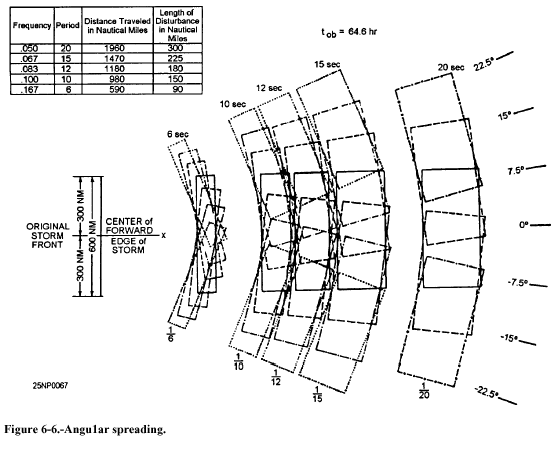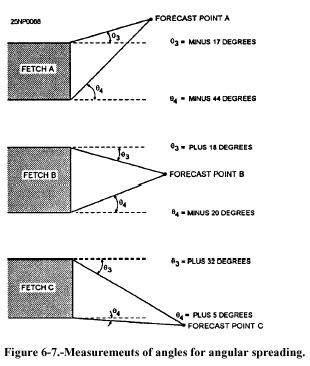FORECASTING SWELL WAVESLEARNING OBJECTIVES: | Explain swell wave generation and recognize the two fundamental modifications that sea waves undergo as they leave the fetch area. Define the terms associated with swell waves, and explain the five rules used to determine how much of the swell will reach the forecast point. Prepare
|
In the preceding portion of this chapter, we have discussed the principles of sea waves and methods of forecasting them. With sea wave forecasting we are considering the point that we are forecasting to be within the generating area, with the wind still blowing. This, however, will not be the problem in the majority of the forecasts that will be required. Normally the forecast point will be outside the fetch area; therefore, it will be necessary to determine what effect the distance traveled is going to have on the waves. In this section we will discuss the basic principles of swell waves as well as an objective method of determining what changes will take place in the spectrum of waves as they traverse from the generating area to the forecast point. After a sea state has been generated in a fetch, there are many different wave trains present with different periods, and most of them are moving out of the fetch in slightly different directions. Because of these different periods and slight differences in direction, the propagation of swell waves follows two fundamental processes. These processes are dispersion and angular spreading.An accepted fact about wave travel is that the waves with longer periods move faster than waves with shorter periods. The actual formula for the speed of the wave train is C=1.515T where C is the speed of the wave train and T is the wave period in the wave train. All of the different wave trains (series of waves all having the same period and direction of movement) in the fetch can be compared to a group of long distance runners at a track and field meet. At first all of the runners start out at the starting line at the same time. As they continue on, however, the faster runners move ahead and the slower runners begin to fall behind. Thus the field of runners begins to string out along the direction of travel. The wave trains leaving a fetch do the same thing. The stringing out of the various groups of waves is called dispersion. In a swell forecast problem it is necessary to determine what wave trains have already passed the forecast point and which have not yet arrived. After this has been determined, the wave trains that are left are the ones that are at the forecast point at the time of observation.  As the wave trains leave the fetch, they may leave at an angle to the main direction of the wind in the fetch. Thus, swell waves may arrive at a forecast point though it may lie to one side of the mainline of direction of the wind. This process of angular spreading is depicted in figure 6-6. As the wave trains leave the fetch, they may leave at an angle to the main direction of the wind in the fetch. Thus, swell waves may arrive at a forecast point though it may lie to one side of the mainline of direction of the wind. This process of angular spreading is depicted in figure 6-6.
The problem in swell forecasting is to determine how much of the swell will reach the forecast point after the waves have spread out at angles. This is accomplished by measuring the angles from the leeward edge of the fetch to the forecast point. These angles must be measured as accurately as possible, figure 6-7, and are determined by the following five rules: 1. Draw the rectangular fetch. 1. Draw the rectangular fetch.
2. Extend the top and bottom edge of the fetch outward parallel to the main direction of the wind. This is shown as dashed lines in figure 6-7.3. Draw lines from the top and bottom edges of the fetch to the forecast point.4. The angles to the forecast point are designated Theta 3 (q3) and Theta 4 (q4). Theta 3 is measured from the top edge of the fetch and Theta 4 from the bottom edge.5. Any angle that lies above the dashed line is negative while any angle that lies below the dashed line is positive.After the angles Theta 3 and 4 have been measured they are converted to percentages of the swell that will reach the forecast point. This conversion is made by entering sea and swell graph 7, figure 6-8, with the positive or negative angles and reading the corresponding percentages directly. The percentages are then subtracted ignoring the plus or minus to find the angular spreading.A number of terms used in dealing with forecasting sea waves will be used again in this process; however, a number of new terms will be introduced. Table 6-3 lists most of these terms with their associated symbol and definition.As with objective forecasting of sea waves there are a number of different methods for forecasting swell waves. Some of the methods are too technical or time consuming to be of practical use.When ship operations are conducted outside a fetch area it becomes necessary to forecast swell conditions at that location. Prior to computing swell conditions the height and period of the significant waves departing the fetch area must be determined. For more details refer to Sea and Swell Forecasting, NAVEDTRA 40560. Prior to computing swell conditions the height and period of the significant waves departing the fetch area must be determined. For more details refer to Sea and Swell Forecasting, NAVEDTRA 40560.
|